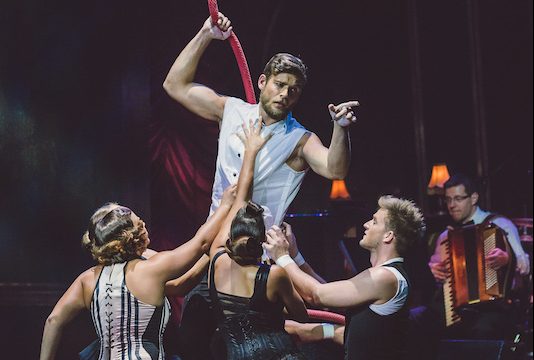Assembly George Square Gardens, Edinburgh Festival Fringe; 10th August 2017

The first theatrical circus company to spring out of Hungary’s strong traditional circus culture has created a stylish entertainment based instead within the traditions of 1930s cabaret, inspired by the Parisian photography of Brassaï and the Fosse dance sensibilities of director Bence Vági.
Gorgeous costumes in blacks and lace are supplemented by a red stiletto or satin bow, and these typically female ornamentations appear equally on male forms. This is a show that deliberately but unprovocatively teases with its sexuality, leaving no taste unacknowledged. The eleven performers wink, smile and roll their eyes at us with a genuine connection, and as the smiling veneer gives way to something more resigned in the characters’ lives, the scenes remain as elegant as ever.
There is no story, but an atmosphere is created through the superb live jazz sextet, gradually moving more towards melancholy over the course of the show, and complicit in every movement of staging and choreography. Some excellent aerial skills – Richárd Herczeg on vertical rope, Zsanett Veress on tight wire, Renátó Illés and Gábor Zsíros on doubles dance trapeze – are supplemented by a precision to the floor-bound dance choreography that I rarely see from circus artists.

A scene with Alexander Kulakov juggling rings – coloured red on one side and white on the other – is a highlight, as he flips an increasing number of props through different planes and body contacts with interesting shifts in pace. The act is counterpointed with Erika Vasas as the ‘glamourous assistant’ who becomes increasingly frustrated with her role, holding the stage powerfully alongside Kulakov with gritted teeth and flailing arms and lending a lovely wrench of darkness beneath the humour.
A set comedy interlude is less than the sum of its parts as Leonetta Lakatos and Hugo Duquette shout and squeal their way through a sequence with a swinging aerial lamp; it’s the small details of burlesque gags throughout the show, where the humour is subtler, that work best.

Rigging changes in the spiegeltent are disappointingly conducted by stagehands dressed in black that don’t gel with the glossy decorative world that otherwise seems so polished, but the final swinging pole they set into place is beautifully used by Herczeg in a soft display from the otherwise butchest looking member of the cast.
Judit Czigány sings original chanson compositions to add to the mood, which really does feel like an atmospheric photograph given form. Nothing goes too deep, but the visual smoothness is well-considered and never slips out of character.
.




